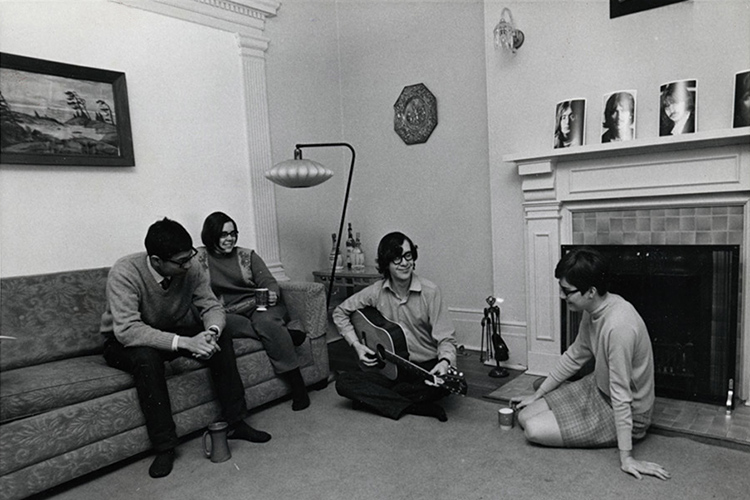This independent, non-profit housing cooperative was founded by a group of engineering students in 1941, when the wartime boom in Kingston was creating an acute shortage of housing for students. The co-op idea was an innovation since the preferred form of accommodation at that time was in boarding houses (there were no men's residences yet, and only one women's residence, Ban Righ Hall).
The first co-op house, for men only, was at 329 Earl Street, where Harkness Hall is now located; the first house for women was added in 1945 at 144 Albert Street.

The outbreak of war in 1939 pushed Kingston out of the Depression as military activity burgeoned as troops poured into the Barriefield base for training. Industrial production such as shipbuilding, aluminum fabrication and nylon manufacture boomed. Between 1939 and 1943, Kingston’s population grew by 9,000 people. Such growth strained the town’s housing supply, and Queen’s students soon felt its effects.
The university didn’t have on-campus accommodation for its male students; women had Ban Righ Hall and a collection of designated houses clustered around the campus. Traditionally, male students had fanned out into the boarding houses of Sydenham Ward, but, with the hot wartime economy, beds were becoming scarce. Encountering this situation in the fall of 1940, a group of Science ’44 freshmen began talking about taking matters into their own hands after hearing that University of Toronto students facing similar conditions had embraced cooperative principles.
By the fall of 1941, a house at 329 Earl Street was ready to open its doors to 16 young owner-tenants. While students did all legal, financial and logistical footwork, Principal Wallace had used his influence to attract a sponsor, prominent applied science graduate Everett Alfred Collins of Science 1905 who had become a senior executive with INCO in New York. Collins agreed to purchase a roomy brick house on Earl St. and turn it over to the university so that it could be put under a long-term lease with Science ’44 Co-operative Incorporated.
Would-be tenants were obliged to become co-op members, paying a dollar a year for the privilege. Room and board cost $8 a week. A cook was hired to prepare meals, but residents were expected to supply their own labour five hours a week for tasks ranging from snow removal to furnace tending. The formula proved workable: in 1941–42 the co-op covered its costs of $6.80 per resident per week and thereby declared a cash dividend of $531.41. Collins House, as it was called, was joined by Berry and Boucher Houses, the latter for women only.
Science ’44 Co-op quickly developed a rich communal life. As students washed dishes or chopped firewood, they got to know one another and built a community. Skating parties, ski trips, canoeing, and sing-songs rounded out the experience.
![[Science ’44 Co-op residents gathered on the steps of one of their houses in the late 1950s]](/encyclopedia/sites/qencwww/files/uploaded_images/175th-images/078-Sci44-500.jpg)
From the outset, co-op culture was about inclusion, and not just for engineering students. Famously, in 1942, when Alfred Bader arrived at Queen’s as a refugee from Europe, the dean of Applied Science sent him to the Science ’44 Co-op where he was given a room and a welcome.
In the 1960s, the co-op encountered financial difficulties and courted bankruptcy, but a 1968 reorganization and a boost from the Board of Trustees and the AMS gave it new life. Subsequent funding from the Canada Mortgage and Housing Corporation allowed the co-op to expand its base, so that today it boasts an larger inventory of houses, full and part-time staff of eight, and accommodation for both Queen’s and St. Lawrence College students.
Learn more about Science '44 Co-op...
